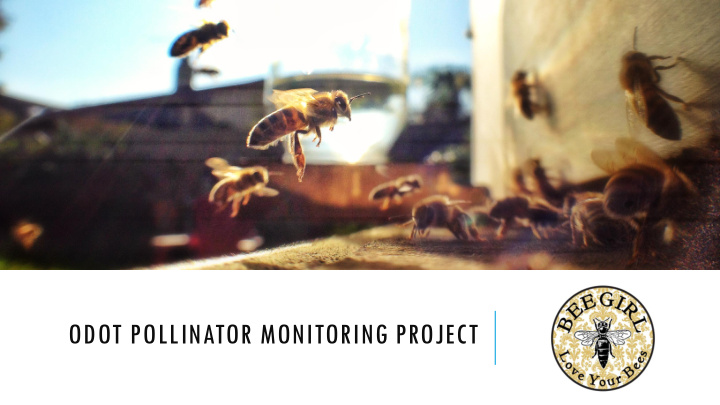



ODOT POLLINATOR MONITORING PROJECT
Bee Girl - University of Montana, Missoula - Iridovirus and Microsporidian Linked to CCD - Sonagraphic analysis of hive health - Pesticide effects - “Bomb sniffing” bees - OLLI
The Bee Girl mission is to inspire and empower communities to conserve bees and their habitat.
Beekeeping Education // Honey Bee Conservation
PRESENT ACTIVITIES Kids and Bees Beekeeping Workshops Farming for Bees Initiative Public Education Next Generation Beekeepers Initiative Public Lands for Bees and Beekeepers Bees and Honey!
Honey Bee Extraordinaire / Scientific Advisor Apiary Based Education Expert Ryan King Scott Debnam Environmental and Botanical Expert / Secretary Tech Savvy Fundraiser / President Mariah Moser Ellen Wright Education Virtuoso Outreach Aficionado / Vise President Jenni Maybin Alicia Fitzgerald Master Food Grower / Law Man Finance Guy / Treasurer Kevin Stout Dustin Poland
ODOT POLLINATOR MONITORING PROJECT Purpose: To monitor pollinator abundance and diversity on the Oregon Department of Transportation (ODOT) vernal pool habitat wetland restoration project, with a focus on bees ( hymenoptera ). Tracking this data will aid in monitoring the success of this project by indicating the health of keystone species habitat. We also hope to provide data-based planting recommendations on future pollinator health projects, as well as explore the relationship between native bees and honey bees.
GOALS/QUESTIONS • Is the restoration supporting bees? • Who is out there (abundance and diversity) • Which seed mixes are the most attractive to bees? • Is there a difference in the un-restored site? • Will the abundance and diversity change over time? • What will happen to the native bee population when we pull the managed honey bee hives?
METHODS • Frequency • Weather • Transects • Keying out the pollinators
CURRENT FINDINGS • One session on 3/31 • Transects: • 4 honey bees, mostly interested in the Limnanthes, also Collinsia, and Erodium • 1 bee fly (family Bombyliidae) • Intuitive control: 2 Apidae Bombus, 20 Apis melifera, 1 Halictidae
STAY IN TOUCH! Sarah Red-Laird sarah@beegirl.org 541-708-1127 Facebook / Instagram @sarahbeegirl #ODOTpollinators
Recommend
More recommend